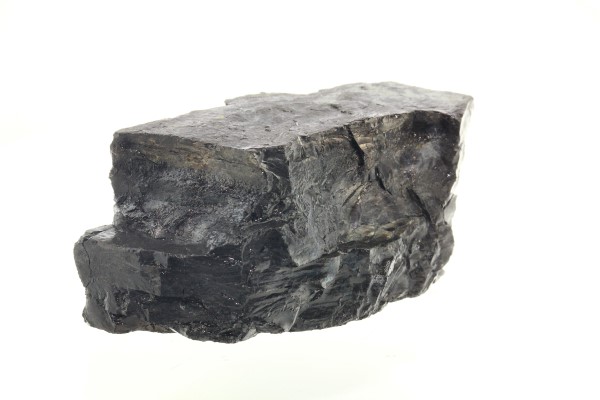
Typical for hard coal is the high luster (in the picture: russian schungite hard coal)
Foto: K. Sieber, www.makrogalerie.de
Schungite is a hard coal rock - according to today's knowledge - formed from algal mud. It most important locality is near Shun'ga in Karelia, Russia (hence the English name "Shungite"). Since Russian geologists refer with the same term »Shungit« to both: the coal-bearing rock (a metamorphic oil shale from the Precambrian that is about 2 billion years old) and the (almost) pure, amorphous coal from this area, both are sold under the same name.
A highly lustrous variant of this bituminous coal, consisting of more than 90% carbon, bears the trade name "precious Shungite". However, the term "precious" applied to a piece of ordinairy coal is highly questionable. None of the criteria commonly used in the gemstone trade for a "precious" stone apply to this black rock. It is neither particularly hard, nor does it show any special color or transparency. And the characteristic "strong luster" is typical for many coals from all over the world.
Quality classification for Shungit-Coal

Categorie 1: "precious Shungite"
Contains 70 - 98% carbon
Black with metallic silvery luster
According to Martino (2013), this rare quality of shungite, comprises only about 1% of the total shungite occurrence. It occurs in very fine veins (maximum width: 40 cm) and is easily recognized by the shell-like chipping. The ocher-colored inclusions are jarosite, an iron sulfate formed by oxidation from pyrite.

Categorie 2: "Shungite schist"
Contains 50 - 70% carbon
Dark gray to black with a matte luster.
This category of shungite is often used to make art objects, because unlike category 1 shungite, shungite schist can be easily worked and polished to a high gloss (Martino, 2013).

Categorie 3: "Shungite slate"
Contains 10 - 50% carbon
Dark gray to brownish gray without luster
Mineralogically a carbonaceous clay schist, comparable to the oil shales of Canada and the USA. Therefore, this rock is much harder and heavier compared to category 1 schungite. Fullerenes have been detected in schungite of this quality (Reznikov et al. 2000).
Due to the deep black color, large quantities of shungite are processed for industrial purposes (color pigments, filler material in car tires, cheap replacement material for carbon filters, etc.). The pure coal ("precious shungite") has a density of 1.5 - 1.8 and is mostly matte, sometimes also metallic to pitch-like shiny. The coal-bearing shungite slate has - depending on the ratio of the carbonaceous and clayey parts - a density between 1.8 and 2.4.
What is special about shungite?
A certain content of "fullerenes" was found in shungite of category 3, which is strongly interspersed within the rock. In so-called "precious" shungite (category 1), however, the fullerenes are completely absent.
Fullerenes consist of carbon, which forms molecules with 60, 70, 80 and more carbon atoms each, which have a spherical structure. By far the best studied fullerene consists of 60 carbon atoms (C60). Its spatial structure consists of 12 pentagons and 20 hexagons, which together form a truncated icosahedron. Since a soccer ball has the same structure, it is also called a soccer molecule ("footballen").
How are fullerenes detected?
Extraction method:
The simplest method to detect fullerenes is to extract them with the solvent toluene. In the presence of fullerenes, the solvent turns brownish red. Calculations by Reznikov et al. (2000) have shown that between 0 and 2 wt% of fullerenes may be present in category 2 and 3 schungites rich in foreign rock. In practice, an extraction rate of 0.1-0.2 wt.% is realistic. This means that only 1-2 gr of fullerenes can be extracted from one kilogram of schungite.
Raman laser analysis
Another possibility to detect fullerenes is by irradiating the sample with laser light. In this process, the fullerene molecules are excited to a characteristic vibration, which can be picked up by a detector. Raman laser analysis can be used not only to detect fullerenes, but also to distinguish between their different modifications (C60, C70 ... ).
Mass spectroscopy
In this method, a sample of rock is chemically or thermally decomposed and the individual components are identified based on their different masses. This method can be used very effectively to detect even small amounts of fullerenes.
EPI laboratory test results (2014)
Sample analyses of schungite samples from various suppliers using extraction methods and Raman analysis showed that fullerenes were NOT detectable in ANY of the samples. This can mean one of two things: Either no fullerenes are present in the commercial samples tested, or the detection methods used were not sensitive enough to detect even the smallest concentrations of fullerenes. However, one thing has been clearly shown by the detection tests: It is not an easy matter to detect fullerenes in schungite.
Conclusion
The results of our fullerene research make it seem questionable whether or to what extent the large quantity of shungite currently circulating as commercially available actually contains fullerenes. It cannot be ruled out that coal or coal-bearing rocks from other parts of the world are currently being marketed as "shungite". The exorbitantly high prices demanded for shungite are very attractive to ordinairy coal traders from all over the world. Since even in shungite coal from Karelia the fullerene content is very unevenly distributed, buyers cannot currently be confident that they are actually purchasing a fullerene-containing product.
Lit.:
Berezkin, V.I.: A soot model for the genesis of Karelian Shungits (2005): Russian Geology Geologiya and Geophysics i Geofizika Vol. 46, No. 10, pp. 1093-1101
Martino, R. (2013): Schungit - Stein der Lebensenergie, Mankau-Verlag, 2. Aufl.
Reznikov, V.A., Polekhovski, Yu.S. (2000): Amorphous Shungite Carbon: A Natural Medium for the Formation of Fullerenes.



